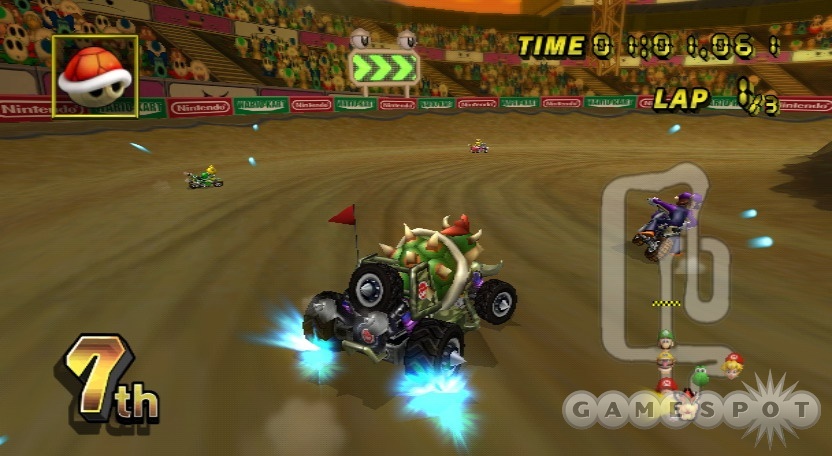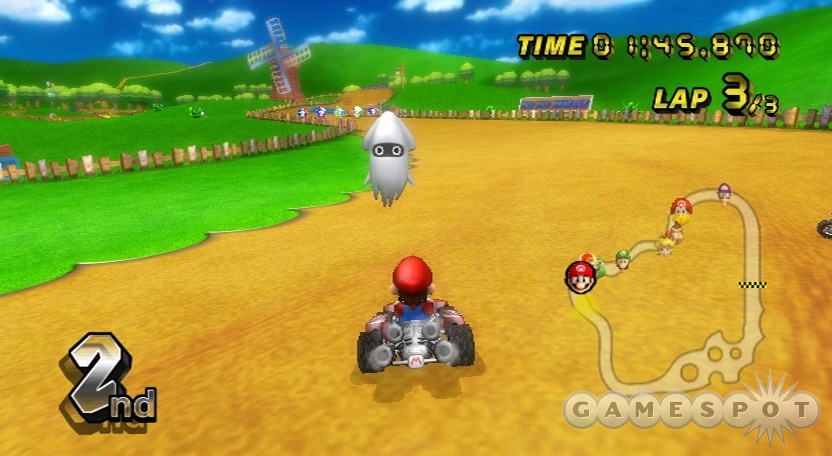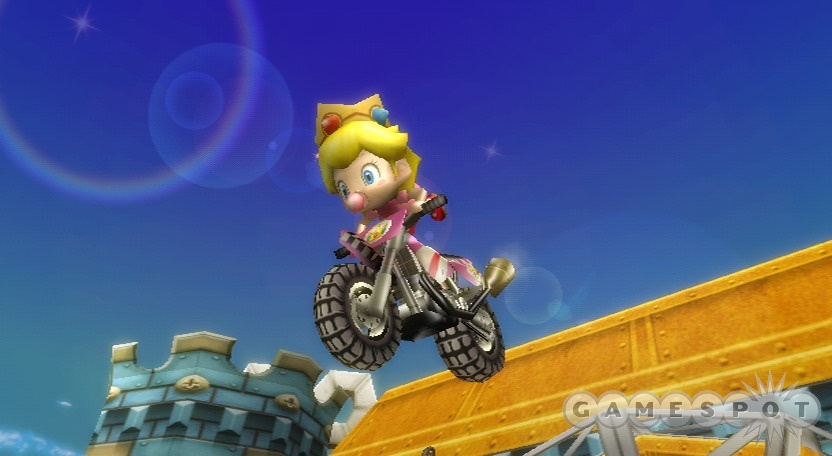One may wonder why Nintendo would add motorcycles and dirt bikes to the game series that popularized, if not invented, the genre of weapons-based go-kart racing. If you're one of the fans who balked at the inclusion of two-wheeled vehicles, a midair stunt system, and motion controls, rest assured that despite these changes, Mario Kart Wii is still very much the game that you have come to love over the years. But even if you haven't been on the receiving end of a blue shell before, the extensive multiplayer options, deeply integrated online functionality, multitude of controller schemes available, and simple gameplay make this latest Mario Kart great fun and quite possibly the most accessible one ever.
The main event of Mario Kart is the Grand Prix mode, which in this version pits you against 11 other computer-controlled competitors in a race to the finish on a four-course cup event. Grand Prix lets you select from three different engine sizes/difficulty settings, and there are initially four cups available, with four more that are unlockable by conquering their predecessors. This makes for a total of 32 different courses, of which half are brand-new for the Wii and the rest remastered versions of classic stages from previous games. This combination of both new and old provides a solid mix of novelty and nostalgia, but overall, the stylistic differences highlight two of the game's greatest flaws.

One of the major new features is the midair stunt system, which is activated by flicking the Wii Remote at the very moment you leave the ground from a ramp-assisted jump, making your racer perform an extreme-sports-style trick, such as a 360-degree spin, which upon landing rewards you with a considerable speed boost. To facilitate this new mechanic, most new tracks include huge half-pipes, rampant ramps, a multitude of moguls, and a plethora of pits, all of which are deliberately placed to encourage extensive stunt work. While this new system itself isn't flawed and in fact injects a great deal of fun and new strategy into the gameplay, its influence on course design has made certain items even deadlier, as you're that much more likely to be blasted uncontrollably into lava or other hazards due to how much time you spend in the air.
The second major track-related issue is that the classic courses, while they've never looked better, are much less engaging than their counterparts. While the newer tracks are wild, crazy, and may even change dynamically as Grumble Volcano or Dry Dry Ruins do, the older courses are their polar opposite and are with few exceptions flat, empty, wide-open, and pit-free. Though you may find the occasional ramp or half-pipe haphazardly bolted on to make it play a teeny bit better with the stunt system, it generally seems like Nintendo deliberately decided to make you choose which was more important: stunts or a slightly better item balance. This dichotomy of level design creates a tenuous balance of play styles and is inelegant at best.
Mario Kart Wii includes the standard batch of items that players have come to expect, including mushrooms, starmen, fake item boxes, shells, and more. New items include the thunder cloud, which will automatically shrink you after several seconds unless you ram someone to pass it off onto them; the POW block, which temporarily stuns everyone ahead of you and makes them drop their items; and the mega mushroom, which makes you grow super large for a time to flatten other racers beneath your tires. While it's pretty much a guarantee of the Mario Kart experience that no one can stay in first forever, some of the more powerful items such as the blue shell, lightning bolt, and POW block appear absurdly often. It's not uncommon to be hit by several of them in a row or even simultaneously if you're in first place.
Much like Super Smash Bros. Brawl before it, Mario Kart Wii includes support for every possible controller configuration under the sun. The game comes packaged with a steering wheel controller shell that allows you to take full advantage of the Wii's motion-sensing abilities for what is perhaps the best purely tilt-driven control scheme available on the market. Though it does take quite a bit of time to get used to, the steering wheel feels quite natural and is very responsive. However, if you're not exactly up to the task or prefer the touch of an analog stick, the Wii Remote with Nunchuk, Classic Controller, or GameCube Controller schemes work just as well, with the directional pads on the more traditional controllers nicely substituting for remote-waggling.

Though the fundamental Mario Kart experience has remained generally the same, there are several changes that can greatly impact gameplay. Drifting mechanics in particular have changed dramatically, both to make it easier to perform for beginners and as a countermeasure against the controversial technique known as snaking (continuously mini-turbo boosting on a straightaway). Mini-turbo boosts are no longer performed by wiggling the analog stick. They are instead determined by the amount of time spent in a drift, and in fact can't be done at all in automatic mode. The type of vehicle you select also affects how drifting works, as go-karts have the ability to super mini-turbo boost by drifting around a turn a bit longer than normal. Motorcycles can't do this, but they can pop wheelies for extra speed on straightaways at the cost of impaired turning and increased susceptibility to ramming attacks. It is worth mentioning that while snaking is still possible to perform--especially on wide and open avenues-- it is no longer as viable or even as helpful as it once was.
Besides Grand Prix, Mario Kart Wii also includes Balloon Battle and Coin Runners battle modes, which take place on 10 separate arenalike tracks, five of which are new and the rest brought out of retirement. Both of these modes have been changed to two team-only events, which is a disappointment to say the least, but they are still fun and entertaining alternatives to standard racing. Split-screen multiplayer allows up to three friends to join you in Grand Prix or battle. Using Nintendo Wi-Fi Connect, you can play online matches with up to 12 total players with a maximum of two per system.

Online integration is deeper than most other games on the Wii, and you can join matches of any game type with friends as well as strangers from your local region or across the world. You have a persistent score, which is either increased or decreased by your performances, and when seeking out matches you're automatically place with like-skilled opponents revealed on a representation of Earth that uses Miis to show the approximate locations of the competition. In the event that you join a game already in progress, you will automatically be placed in a spectator mode until the round finishes and it's go time. Communication between players online is still virtually nonexistent, but while the ability to smack talk is a vital element of local multiplayer, it's not necessary for facilitating matches.
The most interesting online feature of Mario Kart Wii is the Mario Kart Channel, which can either be launched from within the game or saved directly into your Wii dashboard. Using WiiConnect24, you can compare your best lap times against your friends' and the rest of the region or the world. You can also download ghost replays to see firsthand how the top players pull off their times and send your own ghosts to friends as a challenge, and if this channel has been installed in the Wii menu, you can even do all of this without having your Mario Kart disc in the system.
Mario Kart Wii features a cast of 25 characters, over half of which must be unlocked through various accomplishments in single- or multiplayer modes. The ability to race as one of your Miis is perhaps the most notable new feature, but as great as putting Chuck Norris or Dr. Gregory House behind the wheel is, some of the newcomers like Baby Daisy and Dry Bowser are underwhelming and disappointing. Unlike Mario Kart: Double Dash, characters don't have items specific to them, but they do have up to 12 personalized motorcycles and go-karts to select from to determine racing stats.
Graphically, there isn't very much of a leap between this latest Mario Kart and its predecessor on the GameCube, but there are a lot of little details that add to the experience. Crowds of onlookers are populated by your Miis, and posters or statues throughout the levels can feature them as well. Lighting is vastly improved, and there are a number of nice environmental effects. Electricity crackles around you after you've been blasted by a lightning bolt. However, there is a considerable degradation of graphical quality in split-screen multiplayer--especially with four players--and character models are unnaturally shiny.

The musical selections, just like the tracks, are a mixture of old and new, and item sound effects are just as they have always been. Characters, as typical of Nintendo games, only say about four or five different phrases, but these become incredibly grating over time because they say them more often than ever before thanks to midair tricks.
Super Mario Kart may have originated way back in 1992, but 16 years later, Mario Kart Wii proves that the franchise is just as relevant and fun as ever. The all-new stunt system, simplified drifting mechanics, natural motion controls, and expansive online integration all come together in a single package that, despite a few hiccups, is one of the best and most accessible experiences available on the Nintendo Wii.